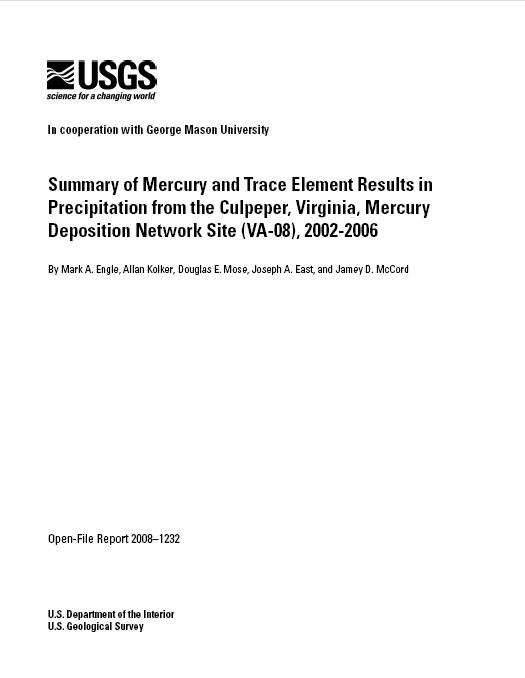Open-File Report 2008–1232

PDF (1.34 MB)
The VA-08 Mercury Deposition Network (MDN) site, southwest of Culpeper, Virginia, was established in autumn of 2002. This site, along with nearby VA-28 (~31 km west) at Big Meadows in Shenandoah National Park, fills a spatial gap in the Mid-Atlantic region of the MDN network and provides Hg deposition data immediately west of the Washington, D.C., metropolitan area. Results for the Culpeper site from autumn of 2002 to the end of 2006 suggest that the highest mercury (Hg) deposition (up to 5.0 µg/m2 per quarter of the 6.5-12.6 µg/m2 annual Hg deposition) is measured during the second and third quarters of the year (April-September). This is a result of both elevated Hg precipitation concentrations (up to 27 ng/L) and greater precipitation during these months. The data also exhibit a general statistically significant (p<0.05) negative correlation between weekly total precipitation and Hg concentrations, suggesting a dilution effect during larger precipitation events, especially during winter and spring. Comparison of results between the Culpeper and Big Meadows sites indicates that although quarterly Hg deposition was not significantly different (p<0.05) between sites, quarterly volume-averaged Hg precipitation concentrations were statistically larger (p<0.05) and precipitation was significantly lower (p<0.05) at VA-08. Lower Hg concentrations at the VA-28 site relative to VA-08 are likely a result of greater total precipitation and thus additional dilution of Hg in precipitation.
Results from concomitant trace elements in precipitation collected from July, 2005, to December, 2006, were used to better identify possible sources of Hg at the Culpeper MDN site. Principal component analysis of the Hg and trace metal data identified 3 primary source categories, each with large loadings of characteristic elements: 1) Ca, Al, Mg, Sr, La, and Ce (crustal sources); 2) V, Na, and Ni (local wintertime heating oil); and 3) Zn, Cd, Mn, and Hg (regional anthropogenic emission sources). HYSPLIT air mass trajectory modeling and enrichment factor calculations are consistent with this interpretation. A preliminary source attribution model suggests that ~51% of the Hg in wet deposition is due to regional anthropogenic sources, while crustal sources and local oil combustion account for 9.5% and <1%, respectively. This calculation implies that the global Hg burden accounts for ~40% of the Hg in wet deposition.For more information, please contact author.
Suggested citatation:
Engle, M.A., Kolker, A., Mose, D.E., East, J.A., and McCord, J.D., 2008, Summary of Mercury and Trace Element Precipitation Results from the Culpeper, Virginia, Mercury Deposition Network Site (VA-08), 2002-2006: U.S. Geological Survey Open File Report 2008-1232, 31 p., available only online.
This document is available online only in Portable Document Format (PDF); the latest version of Adobe Acrobat Reader or similar software is required to view it. Download the latest version of Acrobat Reader, free of charge or go to access.adobe.com for free tools that allow visually impaired users to read PDF files.